Friday, September 27. 2013
Two Opposite Ideologic Territories: The Imperialist Mediterranean Sea vs. the “Archipelic” & Creolized Caribbean
Via The Funambulist
-----
My regular readers would have understood that I develop a certain amount of quasi-pathological obsessions for a certain amounts of ideas or concepts that tend to come back regularly in my articles, in such a way that one could say that each article tends towards an attempt to articulate always the same idea. Among these obsessions is the idea of the archipelago and you will soon see that I did not finish to articulate a few thoughts around this idea yet, since an ambitious project of the same name will soon complement my writing on this blog.
In the following text, I would like to approach the archipelago through the same way that I first did, through a philosopher that has been highly influential to me in this last decade, Édouard Glissant. The archipelago is for him a figure of a utopia towards which the world should tend in order to construct a politics of “the relation” rather than a politics of the universal. Of course, an archipelago is a very evocative example of territories that construct simultaneously the difference between each island, and a collective identity as a group; that is what makes it a strong figure for a new paradigm of sovereignty (see past article). However, according to Glissant, there is an additional complexity to it that enriches this territory of an exemplary ideology. In order to look at it more closely, we need to first observe its opposite, the continental sea — etymologically, the archipelago is also a sea before being a group of islands. The paradigmatic example of the continental sea, because of both its history and its contemporaneity is the Mediterranean Sea. The following excerpt is what he writes about it in one of his only translated books in English, about which we might want to observe the difficulty to translate the language — Glissant was talking about translation as an emerging art in itself — that Betsy Wings brilliantly managed to translate from French to English:
Compared to the Mediterranean, which is an inner sea surrounded by lands, a sea that concentrates (in Greek, Hebrew, and Latin antiquity and later in the emergence of Islam, imposing the thought of the One), the Caribbean is, in contrast, a sea that explodes the scattered lands into an arc. A sea that diffracts. Without necessarily inferring any advantage whatsoever to their situation, the reality of archipelagos in the Caribbean or the Pacific provides a natural illustration of the thought of Relation. (Édouard Glissant, The Poetics of Relation, trans Betsy Wing, Ann Harbor: University of Michigan Press, 1997)
When one looks at maps of the history of the Mediterranean Sea, whether dominated by the Greeks, the Romans, the Christians, the Muslims, the Ottomans, or the European colons (French, British and Italians), one can easily understand the consistence of the efforts that have been deployed for centuries to force the multiple into the uniform. In this regard, the Mediterranean itself a sort of virtually neutral territory that each nation, one by one, attempts to dominate in order to bring one’s identity to the rank of universal norm. The fact that the three largest monotheist religions — two of which are still the most populated in the world — emerged and developed around the Mediterranean, is symptomatic for Glissant of this obsessive will to unify. The geography of the region is, of course, not alone to blame, but one understands that in the case of the Mediterranean Sea, the territory of water constitutes a certain object of covetousness for the nations that surround it.
The Caribbean, as an archipelago constitutes, on the contrary, a layout of islands for which the water is the environing milieu; there is therefore no desire to dominate it since it has virtually no limits, and thus does not constitute a territory per se. History has not been ‘tender’ with these islands as they were the first territories discovered in the late 15th-century by Christopher Columbus who enslaved the indigenous population. Starting in the beginning of the 18th-century, during the colonial domination of the Spanish, the French and the British, hundreds of thousands of African slaves were brought by boat — the vessel of colonial uniformization for Glissant — and provided the manpower of the colonies until the first part of the 19th-century when slavery was progressively abolished. In the meantime, in 1791, Toussaint L’Ouverture and the slaves of Saint-Domingue won a historical war against the French colons and created an autonomous territory on what is now Haiti. The current blockade on Cuba from the United States is also revealing the various tensions that are still operative around this special territory.
Nonetheless, the Caribbean is also the territory of a concept that Glissant work his all life around, the one of creolization. Creole itself often refers to one of the local languages spoken in the Caribbean as something that emerged from the encounter of the colonial language (mostly Spanish and French) and the various languages spoken by the slave population. In general, creole can refer to a similar linguistic evolutionary process between any number of languages (colonial/colonized or not), and even at a broader level, the phenomenon of creolization, as understood by Glissant, constitutes a process in which any aspect of an individual or collective identity encounters another to create a new one, richer because integrating the difference, if not opposition, from which it is born. The jazz is one of the mot evocative example of such a process, as it was invented in the American plantations by slaves after their encounters with European music instruments. This music cannot possibly be considered without the resistive struggle that its birth constituted, since any act of freedom — creativity being at the paroxysm of it — accomplished by the slave materializes by definition a negation of his or her status.
The archipelago is the territory of creolization par excellence, as it embodies a geography of islands whose coast are in continuous contact with the unexpected — another important component of Glissant’s philosophy/poetry — of the otherness. The processes of exchanges — pacific or violent — that occur on it are a form of recognition of the difference with the otherness, that then construct voluntarily or not new aspects of individual and collective identities that are richer than a simple synthesis of the two original ones. In this regard, Glissant’s philosophy of the Relation can be understood as the social interpretation of Baruch Spinoza’s philosophy of affects that I have been evoking many times in the past. Just like Spinoza, Glissant starts by analyzing the world in a ‘neutral’ way, unfolding the nature of exchanges between humans and nations, and only then establishes an ethics based on this philosophical scheme. For Glissant, the archipelago constitutes the territory of his ethics.
For more in English about the philosophy and history of the Caribbean, consult the excellent Public Archive edited and written by Professor Peter Hudson.
Saturday, September 21. 2013
fabric | ch new project: a geo-engineered troposphere in the form of open data feeds (@Close_Closer)
By fabric | ch
-----
Deterritorialized Living is a new project by fabric | ch that we've just published online last week, in relation with the Call and the Talks we are presenting during Close, Closer, the 3rd Lisbon Architecture Triennale curated by Beatrice Galilee (first talk is today, September, 21 at 5pm, LX Factory, Rua Rodrigues Faria, Lisbon, while the second one will be on December, 14).
This project is the result of a residency we did in Beijing last spring, at the Tsinghua University (TASML) and has certainly some unconscious relation with the experience of climate we had in the city!
http://www.deterritorialized.org, the server of Deterritorialized Living, the artificial and livable troposphere.
Deterritorialized Living is an artificial troposphere that reverses our causal relationship to the natural rhythms of day and night, air, seasons, time. It is a “man made” environment where the atmosphere is the effect, continuously shaped from the global activities on the networks produced by humans and robots. The aim of this artificial, almost fictional atmosphere is to give permanent presence (at this stage only in the form of data flows) to what has paradoxically become an ambient, "atmospheric" and contextual experience of deterritorialisation / detemporalisation induced by the massive use of networks, transportation devices, flows of data or communication technologies. Therefore, to literally become able to "breathe" the environment we are generating through our common actions. To some extent, Deterritorialized Living could then also be considered as an information design, delivered in the form of an atmosphere.
As the result of its initial and designed rules, this milieu develops strange behaviors: daylight is always “on” (as there are always activities on the networks) but at variable strengths, nighttime never occurs, air composition regularly reaches “physiological enhancement” levels of high altitude, it is composed of a unique single day that goes back and forth and that ideally last forever, continuous. There are no months, no years.
Deterritorialized Living is delivered in the form of open data feeds which define this “geo-engineered” yet livable environment, computed by the deterritorialized.org server. We expect to develop and use the troposphere in the future in the form of installations, responsive devices and architecture projects.
But the artificial troposphere is also freely available to architects, artists, designers, scientists and makers of all kinds in the form of different “services”: Deterritorialized Air (N2, O2, CO2, Ar), Deterritorialized Daylight (visible light Intensity, IR, UV) and Deterritorialized Time (HH:MM:SS). Additional feeds and refined rules will be added along the time to mature this generated atmosphere.


The live parameters, data and charts that show the evolution of values for Deterritorialized Air (N2, O2, AR, CO2).



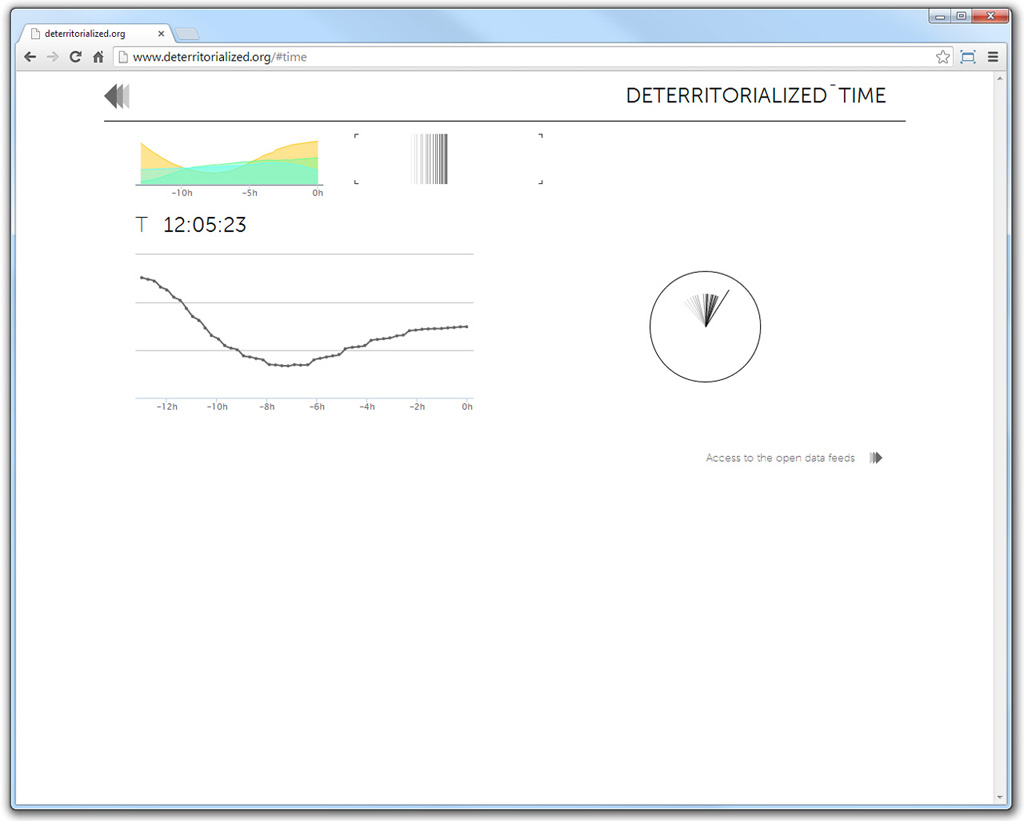
Values for Deterritorialized Daylight, including Intensity (lm, visible light), Infrared (w) and ultraviolet (w) as well as Deterritorialized Time (HH:MM:SS), with their related charts. It is interesting to note that the generated time changes along time... but not in a linear manner, it varies between 06:32 and 19:36.

Man page explaining how to access the different data feeds for the ones who would like to develop their own project out of Deterritorialized Living.
These algorithmically designed data feeds can therefore be used independently or combined to drive experimental devices, interfaces, software and speculative livable environments of all kinds (under the responsibility of their authors...).
Let us know if you'll be using it!
Related Links:
Friday, September 20. 2013
How to make players sick in your virtual reality game
Via Joystiq
-----
There is a great, undiscovered potential in virtual reality development. Sure, you can create lifelike virtual worlds, but you can also make players sick. Oculus VR founder Palmer Luckey and VP of product Nate Mitchell hosted a panel at GDC Europe last week, instructing developers on how to avoid the VR development pitfalls that make players uncomfortable. It was a lovely service for VR developers, but we saw a much greater opportunity. Inadvertently, the panel explained how to make players as queasy and uncomfortable as possible.
And so, we now present the VR developer's guide to manipulating your players right down to the vestibular level. Just follow these tips and your players will be tossing their cookies in minutes.
Note: If you'd rather not make your players horribly ill and angry, just do the opposite of everything below.
Include lots of small, tight spaces
In virtual reality, small and closed-off areas truly feel small, said Luckey. "Small corridors are really claustrophobic. It's actually one of the worst things you can do for most people in VR, is to put them in a really small corridor with the walls and the ceiling closing in on them, and then tell them to move rapidly through it."
Meanwhile, open spaces are a "relief," he said, so you'll want to avoid those.
Possible applications: Air duct exploration game.
Create a user interface that neglects depth and head-tracking
Virtual reality is all about depth and immersion, said Mitchell. So, if you want to break that immersion, your ideal user interface should be as traditional and flat as possible.
For example, put targeting reticles on a 2D plane in the center of a player's field of view. Maybe set it up so the reticle floats a couple of feet away from the player's face. "That is pretty uncomfortable for most players and they'll just try to grapple with what do they converge on: That near-field reticle or that distant mech that they're trying to shoot at?" To sample this effect yourself, said Mitchell, you can hold your thumb in front of your eyes. When you focus on a distant object, your thumb will appear to split in two. Now just imagine that happening to something as vital a targeting reticle!
You might think that setting the reticle closer to the player will make things even worse, and you're right. "The sense of personal space can make people actually feel uncomfortable, like there's this TV floating righting in front of their face that they try to bat out of the way." Mitchell said a dynamic reticle that paints itself onto in-game surfaces feels much more natural, so don't do that.
You can use similar techniques to create an intrusive, annoying heads-up display. Place a traditional HUD directly in front of the player's face. Again, they'll have to deal with double vision as their eyes struggle to focus on different elements of the game. Another option, since VR has a much wider field of view than monitors, is to put your HUD elements in the far corners of the display, effectively putting it into a player's peripheral vision. "Suddenly it's too far for the player to glance at, and they actually can't see pretty effectively." What's more, when players try to turn their head to look at it, the HUD will turn with them. Your players will spin around wildly as they desperately try to look at their ammo counter.
Possible applications: Any menu or user interface from Windows 3.1.
Disable head-tracking or take control away from the player
"Simulator sickness," when players become sick in a VR game, is actually the inverse of motion sickness, said Mitchell. Motion sickness is caused by feeling motion without being able to see it ? Mitchell cited riding on a boat rocking in the ocean as an example. "There's all this motion, but visually you don't perceive that the floor, ceiling and walls are moving. And that's what that sensory disconnect ? mainly in your vestibular senses ? is what creates that conflict that makes you dizzy." Simulator sickness he said, is the opposite. "You're in an environment where you perceive there to be motion, visually, but there is no motion. You're just sitting in a chair."
If you disable head-tracking in part of your game, it artificially creates just that sort of sensory disconnect. Furthermore, if you move the camera without player input, say to display a cut-scene, it can be very disorienting. When you turn your head in VR, you expect the world to turn with you. When it doesn't, you can have an uncomfortable reaction.
Possible applications: Frequent, Unskippable Cutscenes: The Game.
Feature plenty of backwards and lateral movement
Forward movement in a VR game tends not to cause problems, but many users have trouble dealing with backwards movement, said Mitchell. "You can imagine sometimes if you sit on a train and you perceive no motion, and the train starts moving backwards very quickly, or you see another car pulling off, all of those different sensations are very similar to that discomfort that comes from moving backwards in space." Lateral movement ? i.e. sideways movement ? has a similar effect, Mitchell said. "Being able to sort of strafe on a dime doesn't always cause the most comfortable experience."
Possible applications: Backwards roller coaster simulator.
Quick changes in altitude
"Quick changes in altitude do seem to cause disorientation," said Mitchell. Exactly why that happens isn't really understood, but it seems to hold true among VR developers. This means that implementing stairs or ramps into your games can throw players for a loop ? which, remember, is exactly what we're after. Don't use closed elevators, as these prevent users from perceiving the change in altitude, and is generally much more comfortable.
Possible applications: A VR version of the last level from Ghostbusters on NES. Also: Backwards roller coaster simulator.
Don't include visual points of reference
When players look down in VR, they expect to see their character's body. Likewise, in a space combat or mech game, they expect to see the insides of the cockpit when they look around. "Having a visual identity is really crucial to VR. People don't want to look down and be a disembodied head." For the purposes of this guide, that makes a disembodied head the ideal avatar for aggravating your players.
Possible applications: Disembodied Heads ... in ... Spaaaaaace. Also: Disembodied head in a backwards roller coaster.
Shift the horizon line
Okay, this is probably one of the most devious ways to manipulate your players. Mitchell imagines a simulation of sitting on a beach, watching the sunset. "If you subtly tilt the horizon line very, very minimally, a couple degrees, the player will start to become dizzy and disoriented and won't know why."
Possible applications: Drunk at the Beach.
Shoot for a low frame rate, disable V-sync
"With VR, having the world tear non-stop is miserable." Enough said. Furthermore, a low frame rate can be disorienting as well. When players move their heads and the world doesn't move at the same rate of speed, its jarring to their natural senses.
Possible applications: Limitless.
In Closing
Virtual reality is still a fledgling technology and, as Luckey and Mitchell explained, there's still a long way to go before both players and developers fully understand it. There are very few points of reference, and there is no widely established design language that developers can draw from.
What Luckey and Mitchell have detailed - and what we've decided to ignore - is a basic set of guidelines on maintaining player comfort in the VR space. Fair warning though, if you really want to design a game that makes players sick, the developers of AaaaaAAaaaAAAaaAAAAaAAAAA!!! already beat you to it.
How Mechanical Turkers Crowdsourced a Huge Lexicon of Links Between Words and Emotion
-----
Sentiment analysis on the social web depends on how a person’s state of mind is expressed in words. Now a new database of the links between words and emotions could provide a better foundation for this kind of analysis.

One of the buzzphrases associated with the social web is sentiment analysis. This is the ability to determine a person’s opinion or state of mind by analysing the words they post on Twitter, Facebook or some other medium. Much has been promised with this method—the ability to measure satisfaction with politicians, movies and products; the ability to better manage customer relations; the ability to create dialogue for emotion-aware games; the ability to measure the flow of emotion in novels; and so on. The idea is to entirely automate this process—to analyse the firehose of words produced by social websites using advanced data mining techniques to gauge sentiment on a vast scale. But all this depends on how well we understand the emotion and polarity (whether negative or positive) that people associate with each word or combinations of words. Today, Saif Mohammad and Peter Turney at the National Research Council Canada in Ottawa unveil a huge database of words and their associated emotions and polarity, which they have assembled quickly and inexpensively using Amazon’s crowdsourcing Mechanical Turk website. They say this crowdsourcing mechanism makes it possible to increase the size and quality of the database quickly and easily. Most psychologists believe that there are essentially six basic emotions– joy, sadness, anger, fear, disgust, and surprise– or at most eight if you include trust and anticipation. So the task of any word-emotion lexicon is to determine how strongly a word is associated with each of these emotions. One way to do this is to use a small group of experts to associate emotions with a set of words. One of the most famous databases, created in the 1960s and known as the General Inquirer database, has over 11,000 words labelled with 182 different tags, including some of the emotions that psychologist now think are the most basic. A more modern database is the WordNet Affect Lexicon, which has a few hundred words tagged in this way. This used a small group of experts to manually tag a set of seed words with the basic emotions. The size of this database was then dramatically increased by automatically associating the same emotions with all the synonyms of these words. One of the problems with these approaches is the sheer time it takes to compile a large database so Mohammad and Turney tried a different approach. These guys selected about 10,000 words from an existing thesaurus and the lexicons described above and then created a set of five questions to ask about each word that would reveal the emotions and polarity associated with it. That’s a total of over 50,000 questions. They then asked these questions to over 2000 people, or Turkers, on Amazon’s Mechanical Turk website, paying 4 cents for each set of properly answered questions. The result is a comprehensive word-emotion lexicon for over 10,000 words or two-word phrases which they call EmoLex. One important factor in this research is the quality of the answers that crowdsourcing gives. For example, some Turkers might answer at random or even deliberately enter wrong answers. Mohammad and Turney have tackled this by inserting test questions that they use to judge whether or not the Turker is answering well. If not, all the data from that person is ignored. They tested the quality of their database by comparing it to earlier ones created by experts and say it compares well. “We compared a subset of our lexicon with existing gold standard data to show that the annotations obtained are indeed of high quality,” they say. This approach has significant potential for the future. Mohammad and Turney say it should be straightforward to increase the size of the date database and at the same technique can be easily adapted to create similar lexicons in other languages. And all this can be done very cheaply—they spent $2100 on Mechanical Turk in this work. The bottom line is that sentiment analysis can only ever be as good as the database on which it relies. With EmoLex, analysts have a new tool for their box of tricks. Ref: arxiv.org/abs/1308.6297: Crowdsourcing a Word-Emotion Association Lexicon.
Wednesday, September 18. 2013
Lightning Farm
Via BLDGBLOG
-----

[Image: Triggered lightning technology at the University of Florida's Lightning Research Group].
This past winter, I had the pleasure of traveling around south Florida with Smout Allen, Kyle Buchanan, and nearly two dozen students from Unit 11 at the Bartlett School of Architecture.
Florida's variable terrains—of sink holes, swamps, and eroding beaches—and its Herculean infrastructure, from canals and freeways to theme parks and rocket facilities, served as the narrative backdrop for the many architectural projects ultimately produced by the class (in addition, of course, to the 2012 U.S. Presidential election, the results of which we watched live from the bar of a tropical-themed hotel near Cape Canaveral, next door to Ron Jon).
While there were many, many interesting projects resulting from the trip, and from the Unit in general, there is one that I thought I'd post here, by student Farah Aliza Badaruddin, particularly for the quality of its drawings.


[Images: From a project by Farah Aliza Badaruddin at the Bartlett School of Architecture].
Badaruddin's project explored the large-scale architectural implications of applying radical weather technologies to the task of landscape remediation, asking specifically if Cape Canaveral's highly contaminated ground water—polluted by a "viscous toxic goo" made from tens of thousands of pounds of rocket fuels, chemical plumes, solvents, and other industrial waste products over the decades—could be decontaminated through pyrolysis, using guided and controlled bursts of lightning.
In her own words, Badaruddin explains that the would test "the idea that lightning can be harnessed on-site to pyrolyse highly contaminated groundwater as an approach to remediate the polluted site."
These controlled and repetitive lightning strikes would also, in turn, help fertilize the soil, producing a kind of bio-electro-agricultural event of truly cosmic (or at least Miller-Ureyan) proportions.
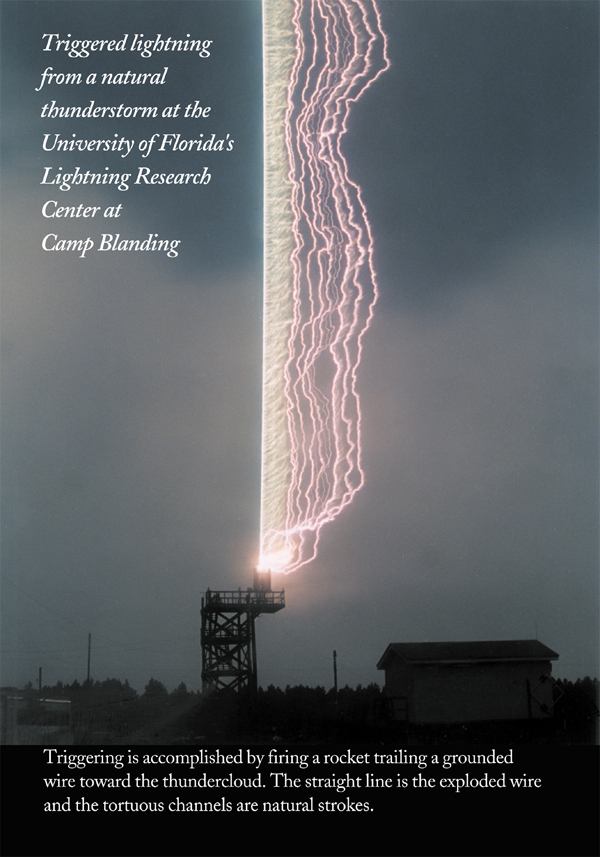
[Image: Triggered lightning technology at the University of Florida Lightning Research Group].
Her maps of the area—which she presents as if drawn in a Moleskine notebook—show the terrestrial borders of the proposal (although volumetric maps of the sky, showing the project's fully three-dimensional engagement with regional weather systems, would have been an equally, if not more, effective way of showing the project's spatial boundaries).
This raises the awesome question of how you should most accurately represent an architectural project whose central goal is to wield electrical influence on the atmosphere around it.






[Images: From a project by Farah Aliza Badaruddin at the Bartlett School of Architecture].
In short, her design proposes a new infrastructure of "rocket-triggered lightning technology," assisted and supervised by a peripheral network of dirigibles—floating airships that "surround the site and serve as the observatory platform for a proposed lightning visitor centre and the weather research center."
The former was directly inspired by real-world lightning research equipment found at the University of Florida's Lightning Research Group.

[Image: Triggered lightning technology at the University of Florida's Lightning Research Group].
Badaruddin's own rocket triggers would be used both to attract and "to provide direct lightning strikes to the proposed sites," thus pyrolizing the landscape and purifying both ground water and soil.

[Image: Aerial collage view of the lightning farm, by Farah Aliza Badaruddin at the Bartlett School of Architecture].
The result would be a lightning farm, a titanic landscape tuned to the sky, flashing with controlled lightning strikes as the ground conditions are gradually remediated—an unmoving, nearly permanent, artificial electrical storm like something out of Norse mythology, cleansing the earth of toxic chemicals and preparing the site for future reuse.

[Image: Collage of the lightning farm, by Farah Aliza Badaruddin at the Bartlett School of Architecture].
I should say that my own interest in these kinds of proposals is less in their future workability and more in what it means to see a technology taken out of context, picked apart for its spatial implications, and then re-scaled and transformed into a speculative work of landscape architecture. The value, in other words, is in re-thinking existing technologies by placing them at unexpected scales in unexpected conditions, simultaneously extracting an architectural proposal from that and perhaps catalyzing innovative new ways for the original technology itself to be redeveloped or used.

[Image: Farah Aliza Badaruddin].
It's not a question of whether or not something can be immediately realized or built; it's a question of how open-ended, fictional design proposals can change the way someone thinks about an entire field or class of technologies.

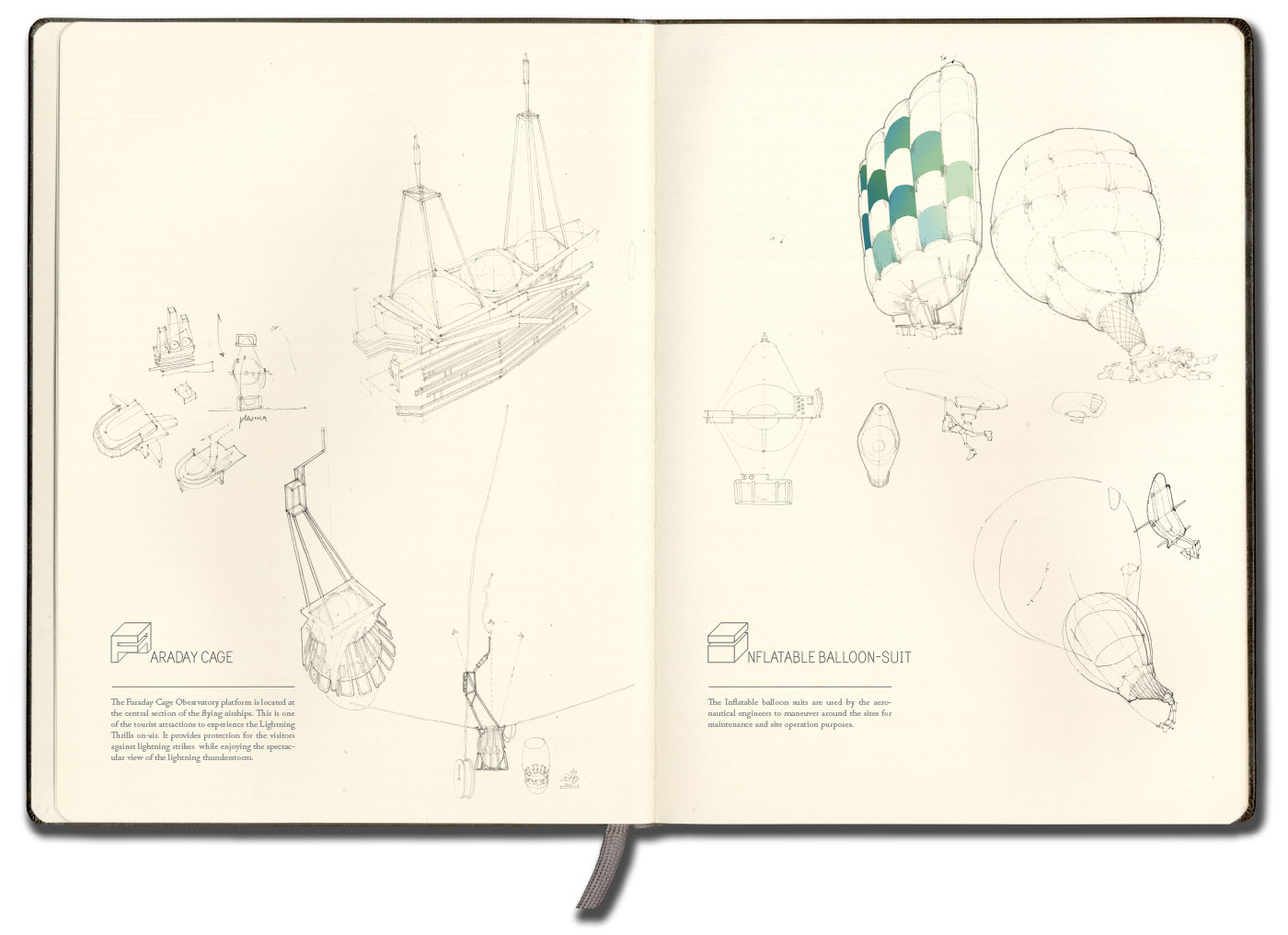



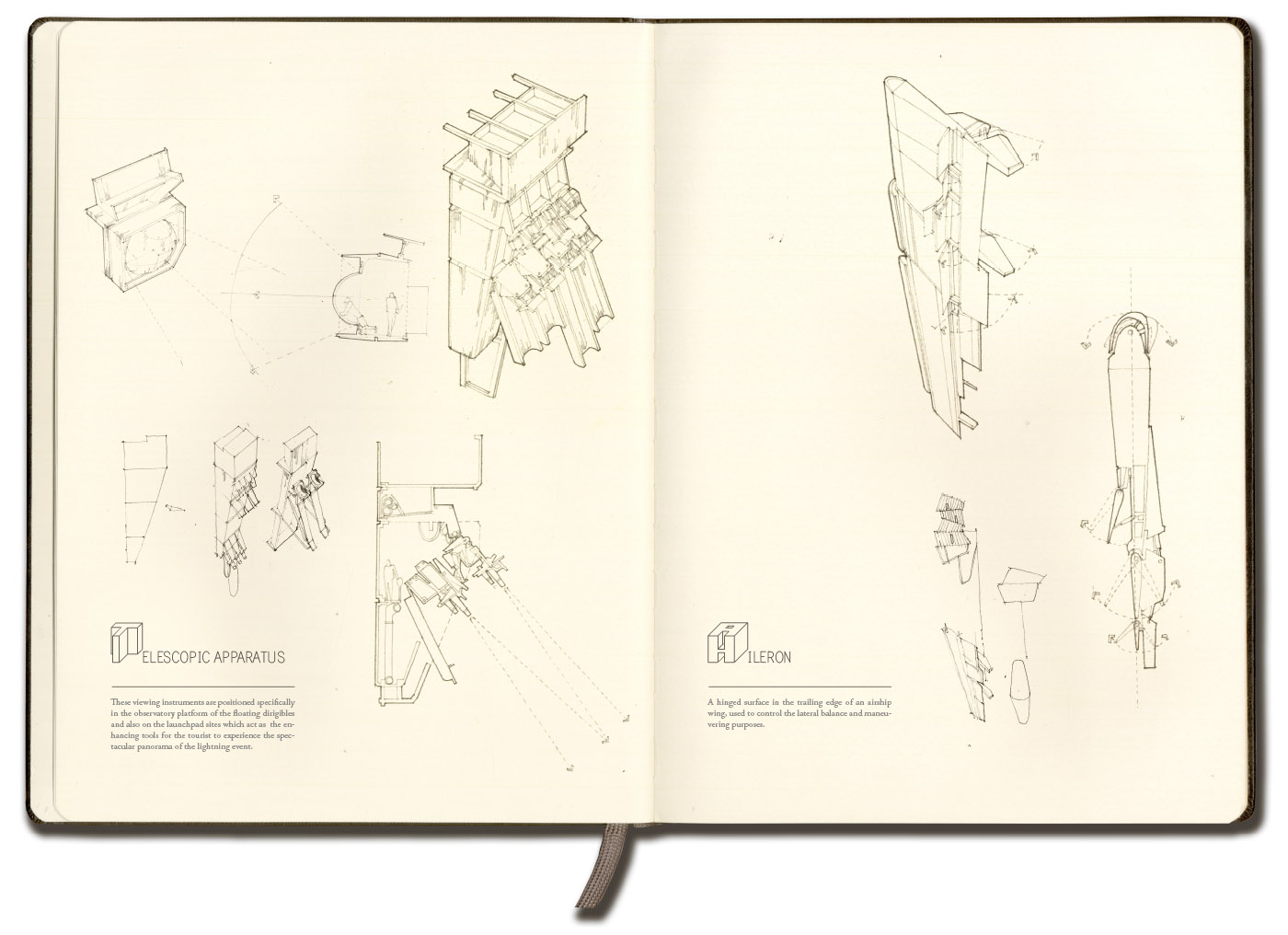
[Images: From a project by Farah Aliza Badaruddin at the Bartlett School of Architecture].
But I'll let Badaruddin's own extraordinary visual skills tell the story. Most if not all of these images can be seen in a much larger size if you open the images in their own windows; they're well worth a closer look—


[Images: From a project by Farah Aliza Badaruddin at the Bartlett School of Architecture].
—including what amount to a short graphic novel telling the story of her proposed controlled-lightning landscape-decontamination facility.

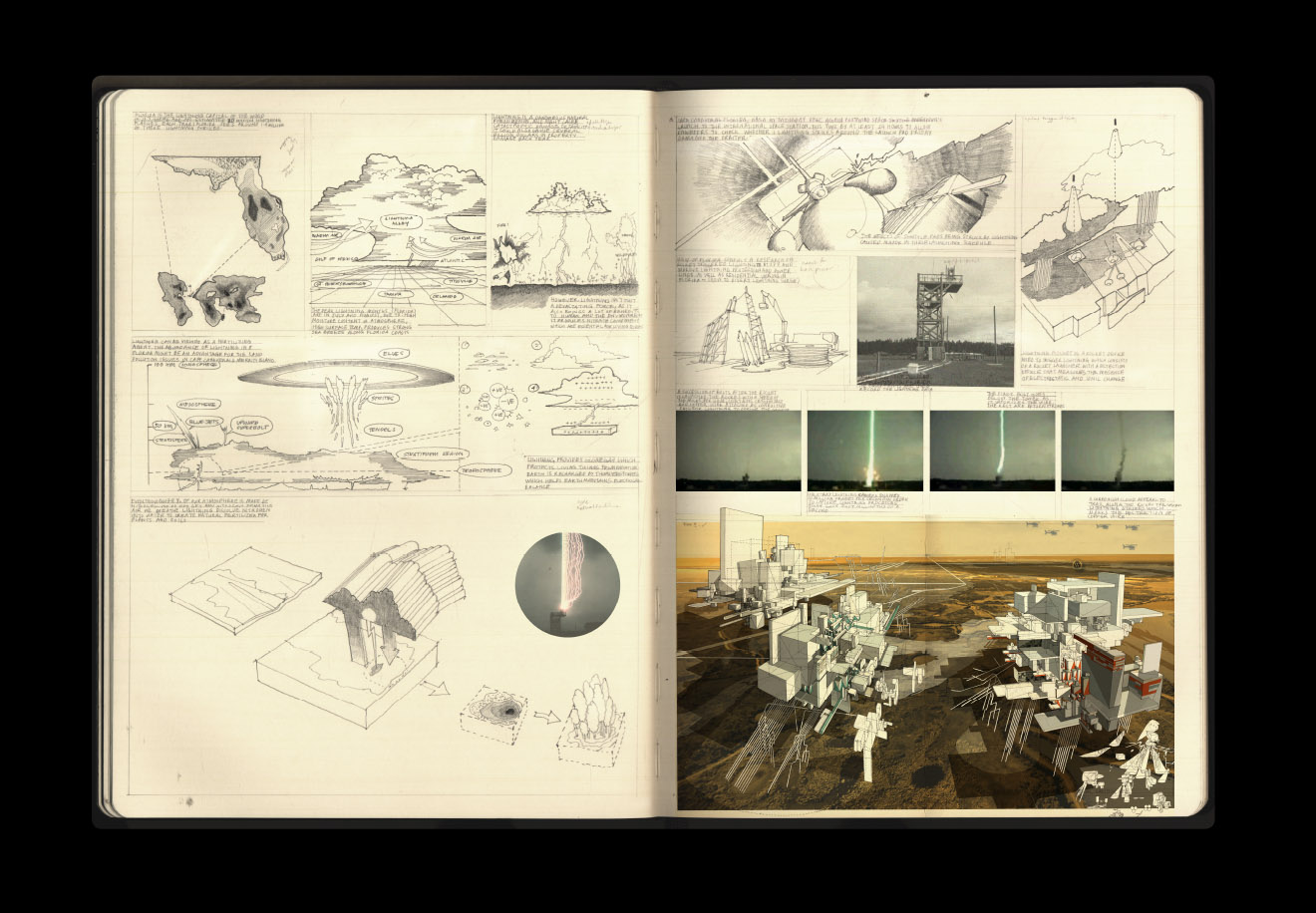
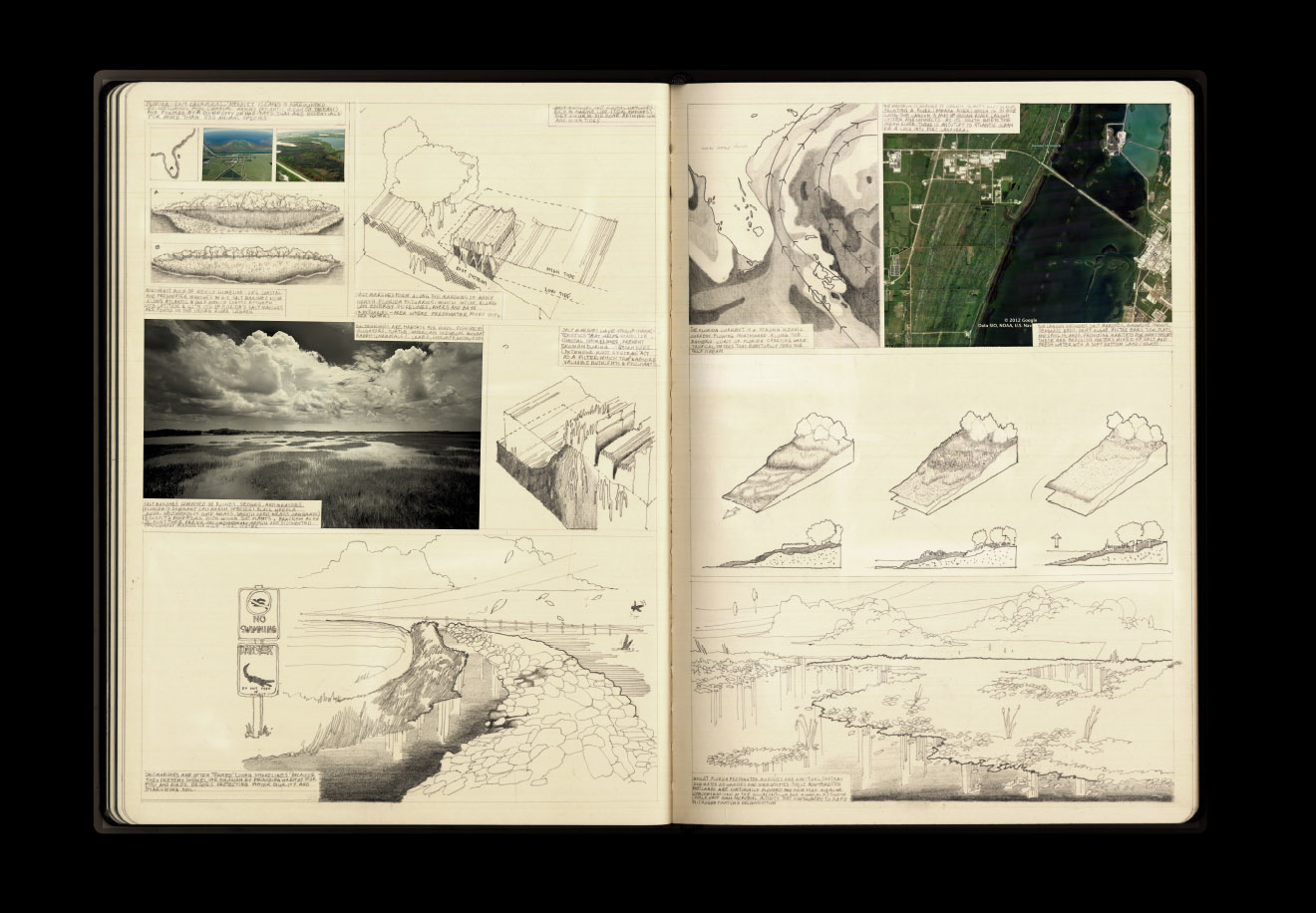
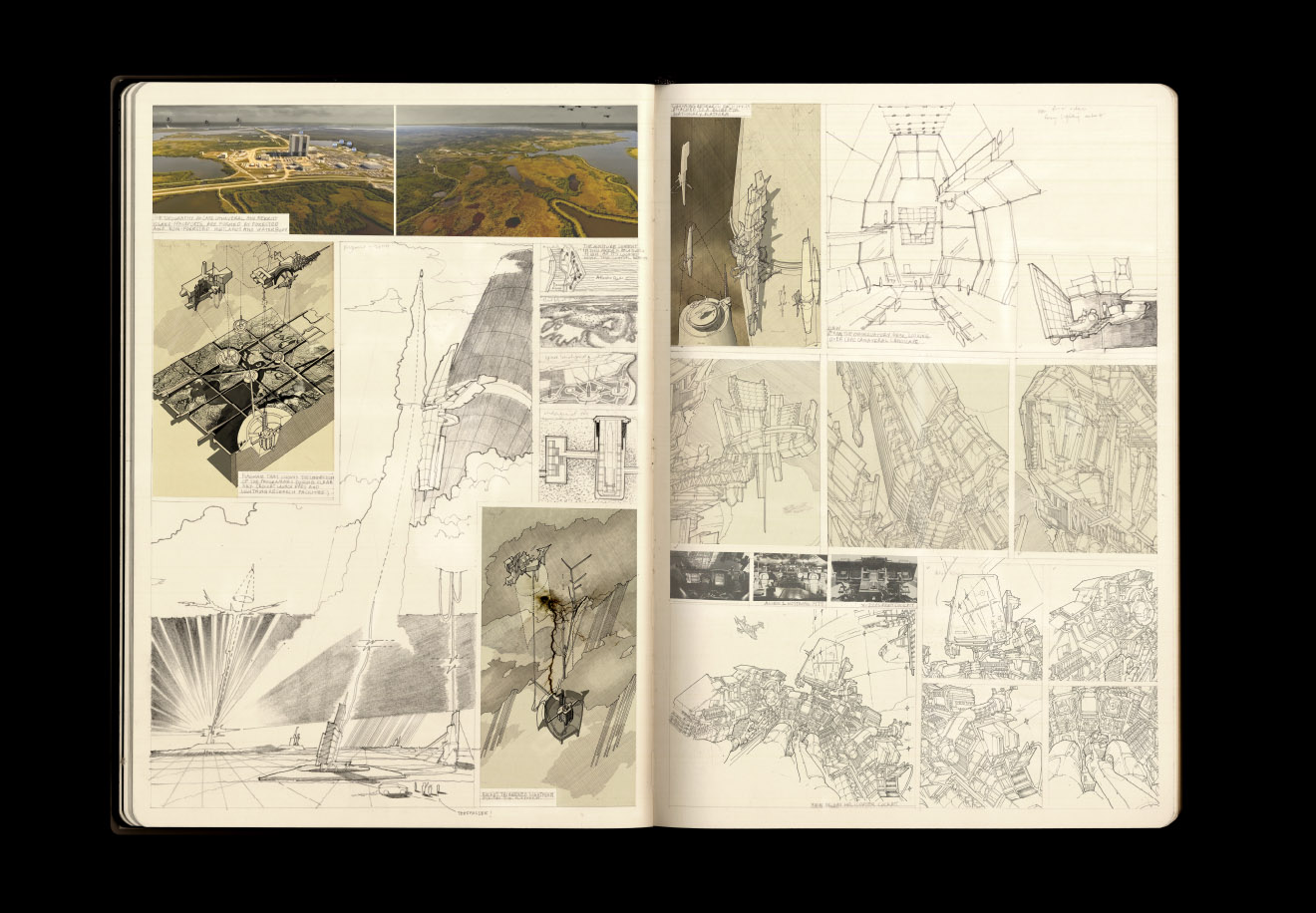

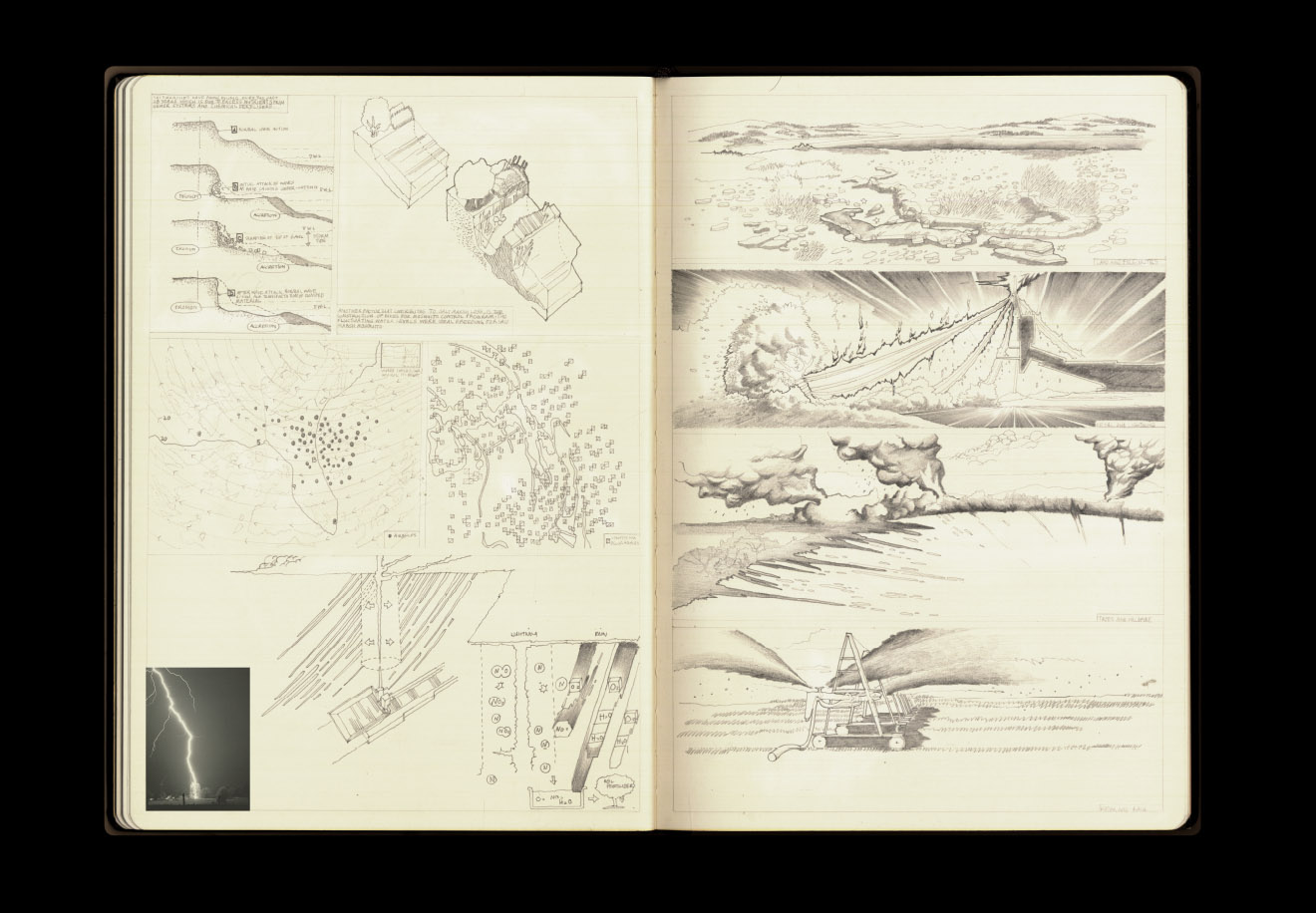
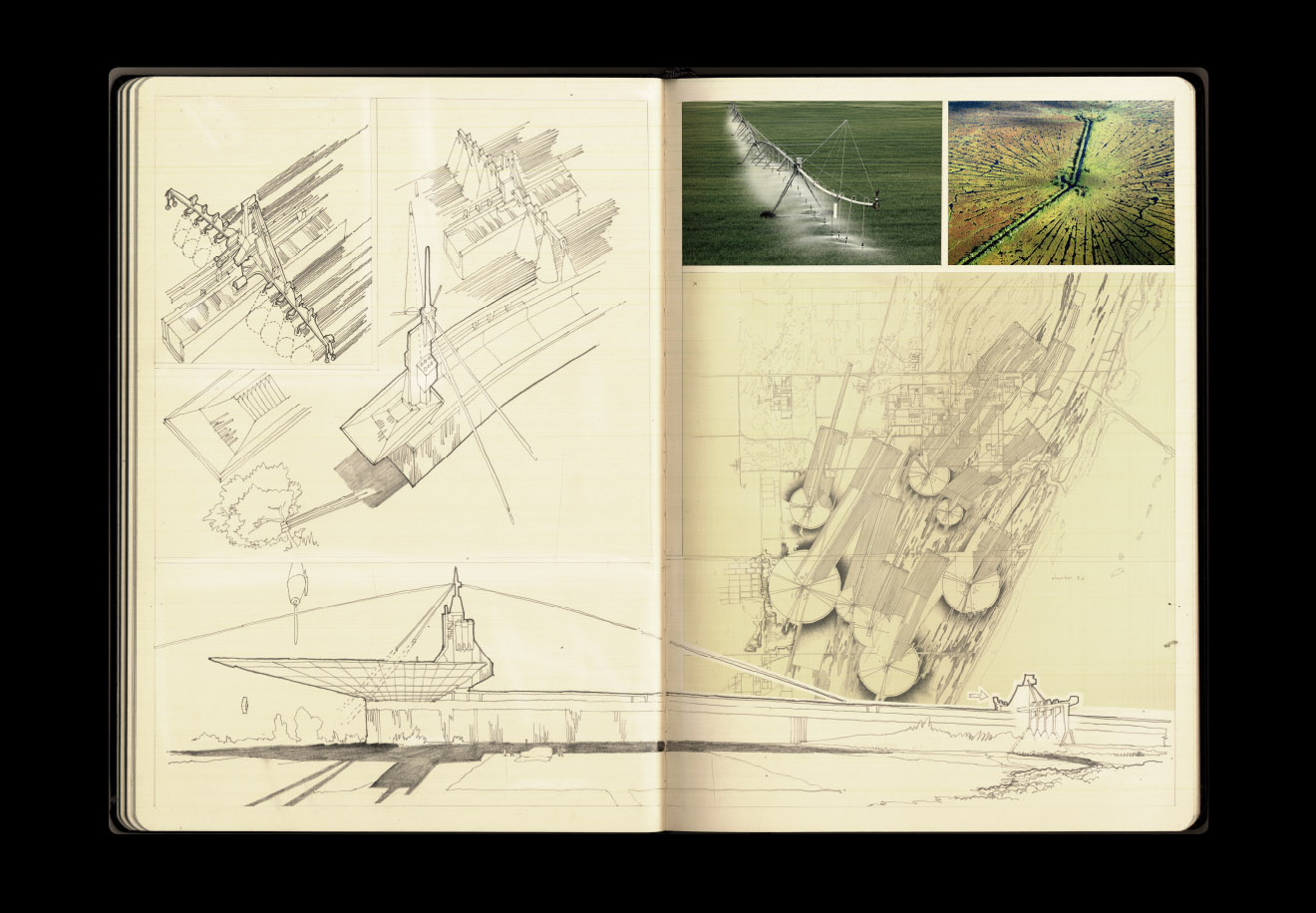

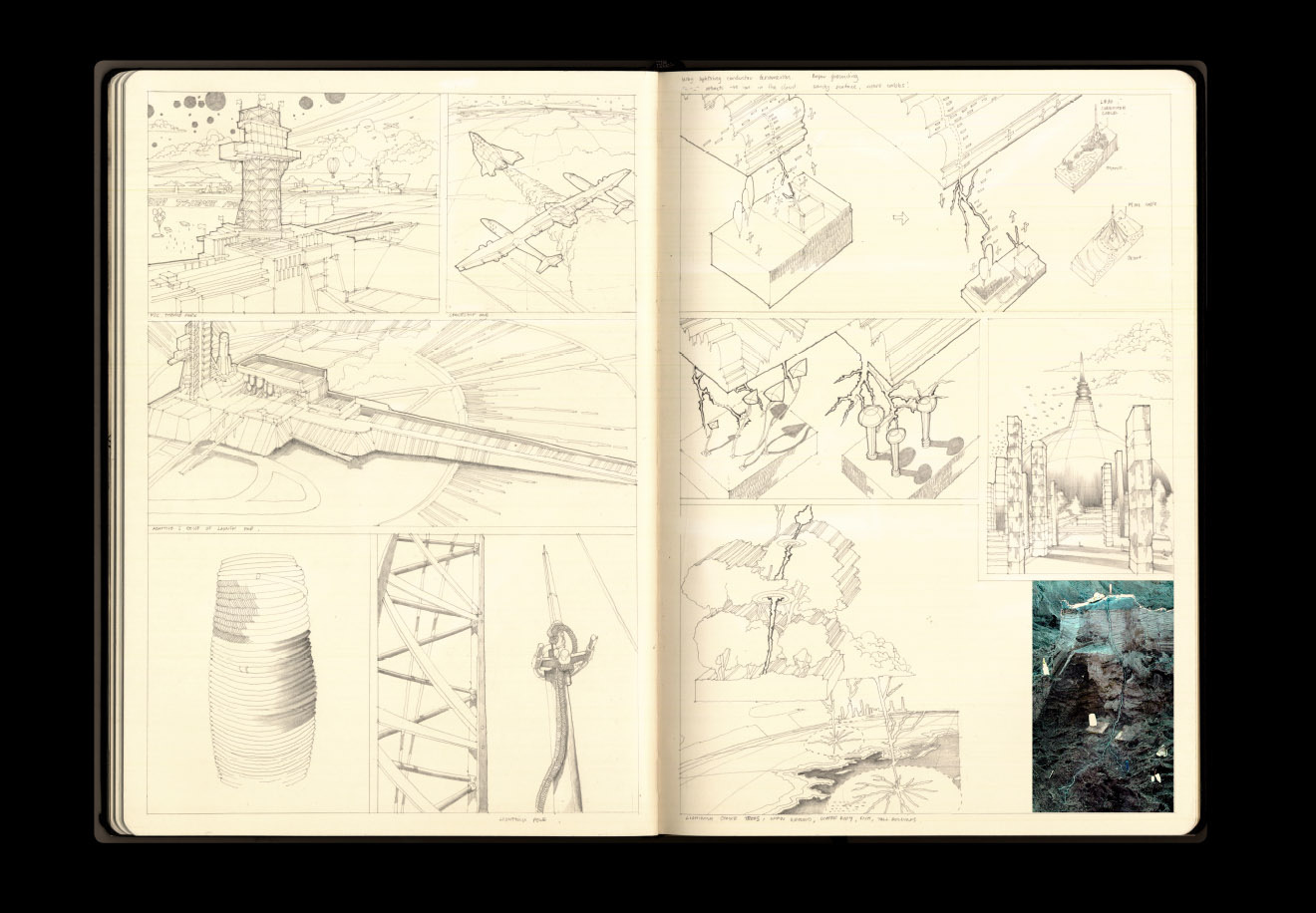
[Images: From a project by Farah Aliza Badaruddin at the Bartlett School of Architecture].
All in all, whether or not architecturally-controlled lightning storms will ever purify the land and water of south Florida, it's a wonderfully realized and highly imaginative project, and I hope Badaruddin finds more opportunities, post-Bartlett, to showcase and develop her skills.
fabric | rblg
This blog is the survey website of fabric | ch - studio for architecture, interaction and research.
We curate and reblog articles, researches, writings, exhibitions and projects that we notice and find interesting during our everyday practice and readings.
Most articles concern the intertwined fields of architecture, territory, art, interaction design, thinking and science. From time to time, we also publish documentation about our own work and research, immersed among these related resources and inspirations.
This website is used by fabric | ch as archive, references and resources. It is shared with all those interested in the same topics as we are, in the hope that they will also find valuable references and content in it.


